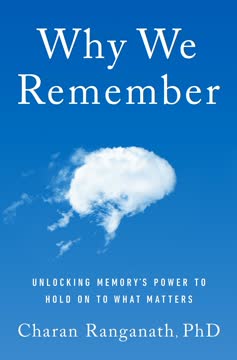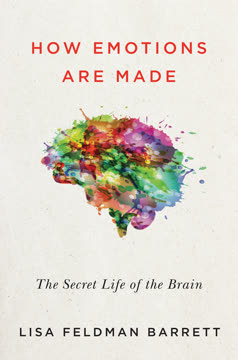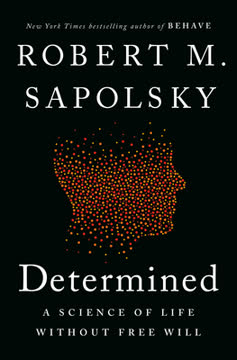نکات کلیدی
1. مغزهای ما ماشینهای پیشبینی هستند که بهطور مداوم ورودیهای حسی را پیشبینی میکنند
مغزها ماشینهای پیشبینی هستند که منابع خارجی را بهراحتی (و به همان دلایل) بهکار میگیرند که اقدامهای عملی را انجام میدهند و جنبههای مختلف مدارهای داخلی خود را فعال میکنند.
مغز پیشبینیکننده. مغزهای ما دریافتکنندههای منفعل اطلاعات نیستند، بلکه موتورهای پیشبینی فعال هستند. آنها بهطور مداوم انتظاراتی دربارهی آنچه که خواهیم دید، خواهیم شنید و خواهیم احساس کرد، بر اساس تجربیات گذشته و الگوهای آموختهشده تولید میکنند. این پردازش پیشبینیکننده به ما اجازه میدهد تا دادههای حسی مبهم یا ناقص را با پر کردن شکافها با بهترین حدسهای خود درک کنیم.
کارایی از طریق پیشبینی. با پیشبینی ورودیهای حسی، مغز میتواند اطلاعات را بهطور مؤثرتری پردازش کند. این مغز تنها نیاز دارد بر تفاوتهای بین پیشبینیها و دادههای حسی واقعی تمرکز کند، نه اینکه همه چیز را از ابتدا پردازش کند. این امر به درک سریع و تصمیمگیری در محیطهای پیچیده کمک میکند.
نمونههایی از پردازش پیشبینیکننده:
- شنیدن یک آهنگ آشنا در یک رادیوی بد و هنوز هم درک کردن متن آن
- شناسایی اشیاء در نمای جزئی یا شرایط نور ضعیف
- تجربه لرزشهای خیالی تلفن به دلیل انتظارات مکرر
2. تجربه از تعامل پیشبینیها و شواهد حسی ناشی میشود
ما جهان را با پیشبینی کردن آن میبینیم. اما زمانی که خطاهای پیشبینی به وجود میآید، مغز باید دوباره پیشبینی کند.
ساخت واقعیت. تجربهی ذهنی ما از جهان، بازتابی مستقیم از واقعیت نیست، بلکه ساختاری است که از تعامل بین پیشبینیهای مغز ما و شواهد حسی ورودی شکل میگیرد. زمانی که پیشبینیها با ورودی حسی مطابقت دارند، ما جهان را همانطور که انتظار داریم درک میکنیم. زمانی که عدم تطابق وجود دارد، مغز ما مدلهای خود را بهروزرسانی میکند تا بهتر با واقعیت همراستا شود.
وزندهی به دقت. مغز به پیشبینیها و دادههای حسی بر اساس قابلیت اطمینان تخمینی آنها سطوح مختلفی از اهمیت (دقت) را اختصاص میدهد. این وزندهی تعیین میکند که هر منبع چقدر بر درک نهایی ما تأثیر دارد. توجه میتواند بهعنوان فرآیند تنظیم این وزنهای دقت برای تمرکز بر اطلاعات مرتبط درک شود.
پیامدها:
- توهمات نوری ناشی از پیشبینیهای مغز که دادههای حسی مبهم را نادیده میگیرد
- انتظارات ما میتوانند درکهای ما را شکل دهند و گاهی منجر به تفسیرهای مغرضانه شوند
- یادگیری شامل بهروزرسانی مدلهای پیشبینی ما برای بهتر مطابقت دادن با جهان است
3. عمل تحت تأثیر پیشبینیهای خودتحققیافته از عواقب حسی است
برای درک کردن، باید پیشبینیهایی را پیدا کنیم که بهترین تطابق را با شواهد حسی دارند. برای عمل کردن، باید جهان را تغییر دهیم تا آن را با برخی از آن پیشبینیها همراستا کنیم.
عمل بهعنوان پیشبینی تحققیافته. در چارچوب پردازش پیشبینیکننده، عملها با پیشبینی عواقب حسی آنها آغاز میشوند. مغز انتظاراتی از آنچه که احساس خواهد کرد هنگام انجام یک عمل تولید میکند و خطاهای پیشبینیشده، سیستم حرکتی را بهکار میگیرد تا آن پیشبینیها به حقیقت بپیوندند.
یکپارچگی درک و عمل. این دیدگاه یک حساب یکپارچه از درک و عمل ارائه میدهد. هر دو شامل حداقل کردن خطاهای پیشبینی هستند، چه از طریق بهروزرسانی مدلهای داخلی (درک) و چه با تغییر جهان برای مطابقت با پیشبینیها (عمل). این امر توضیح میدهد که چرا در رفتارهای ماهرانه، درک و عمل بهطور تنگاتنگی به هم مرتبط هستند.
جنبههای کلیدی عمل پیشبینیکننده:
- کنترل حرکتی بهعنوان "توهم کنترلشده" از نتایج مطلوب
- نقش پروپریوسپشن (حس موقعیت بدن) در اجرای عمل
- چگونگی بهبود عملکرد از طریق تمرین با تصحیح مدلهای پیشبینی
4. احساسات و عواطف از پیشبینیهای بدنی و درونحسی ناشی میشوند
هر چیزی که میبینم، میشنوم، لمس میکنم و احساس میکنم—این علم جدید پیشنهاد میکند—بازتاب چاههای پنهان پیشبینی است.
احساسات بدنی. احساسات تنها حالتهای ذهنی نیستند، بلکه پدیدههای کل بدن هستند که از پیشبینیهای مغز دربارهی وضعیتهای داخلی بدن (درونحسی) ناشی میشوند. احساسات ما از شادی، ترس یا خشم، بازتاب بهترین حدس مغز دربارهی وضعیت فیزیولوژیکی فعلی ما و اهمیت آن برای رفاه ماست.
پردازش پیشبینیکننده درونحسی. مغز بهطور مداوم پیشبینیهایی دربارهی سیگنالهای داخلی بدن (ضربان قلب، تنفس، احساسات درونحسی) تولید میکند و آنها را با ورودیهای حسی واقعی مقایسه میکند. عدم تطابقها بین وضعیتهای بدنی پیشبینیشده و واقعی میتوانند تجربیات عاطفی را تحریک کرده و اقداماتی را برای بازگرداندن تعادل بهوجود آورند.
پیامدها برای درک احساسات:
- نقش بازخورد بدنی در شکلدهی به تجربیات عاطفی
- چگونگی تأثیر انتظارات و زمینه بر تفسیر ما از احساسات بدنی
- پتانسیل تغییر احساسات با تغییر پیشبینیهای درونحسی
5. شرایط روانپزشکی میتوانند بهعنوان تغییرات در پردازش پیشبینی درک شوند
نتیجهگیری باید آغاز یک فرآیند کند اما مهم باشد که تمایزات قدیمی بین روانپزشکی، عصبشناسی و علوم اعصاب محاسباتی را از بین ببرد و در نهایت وحدت بنیادی ذهن، بدن و جهان را بپذیرد.
چارچوب یکپارچه. پردازش پیشبینیکننده یک راه جدید برای درک شرایط مختلف روانپزشکی و عصبی بهعنوان اختلالات در ماشین پیشبینی مغز ارائه میدهد. این رویکرد شکاف بین علائم ذهنی و جسمی را پر میکند و دیدگاه یکپارچهتری از سلامت روان ارائه میدهد.
دقت و روانپریشی. بسیاری از اختلالات میتوانند به عدم تعادل در نحوهی اختصاص دقت مغز به پیشبینیها در مقابل شواهد حسی مرتبط شوند. بهعنوان مثال:
- افسردگی: پیشبینیهای منفی بسیار دقیق دربارهی خود و جهان
- اضطراب: دقت بالای پیشبینیهای مرتبط با تهدید
- اسکیزوفرنی: دقت غیرطبیعی که منجر به توهمات و هذیانها میشود
پیامدها برای درمان:
- هدفگذاری فرآیندهای پیشبینی در درمان و دارو
- استفاده از مداخلات شناختی برای شکلدهی مجدد پیشبینیهای ناسازگار
- بررسی درمانهای نوین که وزندهی دقت را در مغز تعدیل میکنند
6. ذهنهای پیشبینیکنندهی ما فراتر از جمجمههای ما به محیط گسترش مییابند
ذهنهای گسترشیافته بهدلیل اینکه مغزهای پیشبینیکننده بهطور طبیعی در بهرهبرداری از فرصتها برای استفاده از حلقههای عمل جمعآوری اطلاعات ماهر هستند، بهوجود میآیند.
ذهن نفوذپذیر. فرآیندهای شناختی ما در مرزهای مغزهای ما متوقف نمیشوند. ذهن پیشبینیکننده بهراحتی ابزارهای خارجی، فناوریها و ساختارهای محیطی را در استراتژیهای حل مسئله خود ادغام میکند. این منجر به "ذهن گسترشیافته" میشود که مغز، بدن و جهان را در بر میگیرد.
بارگذاری شناختی. ما بهطور مداوم از محیط برای حمایت از تفکر خود و کاهش بار شناختی استفاده میکنیم. نمونهها شامل:
- استفاده از دفترچهها یا تلفنهای هوشمند بهعنوان حافظه خارجی
- دستکاری اشیاء فیزیکی برای کمک به حل مسئله
- بهرهبرداری از تعاملات اجتماعی برای شناخت توزیعشده
پیامدهای شناخت گسترشیافته:
- بازنگری در ماهیت هوش و مرزهای شناختی
- طراحی ابزارها و محیطهای بهتر برای تقویت شناخت انسانی
- بازنگری در نحوهی درک و درمان اختلالات شناختی
7. ما میتوانیم مغزهای پیشبینیکنندهی خود را هک کنیم تا تجربیات و قابلیتهای خود را بهبود بخشیم
درک ماهیت و تأثیرات تعادلهای مختلف در ماشین تجربه همچنین اشکال نرمال و غیرنرمال تجربه انسانی را در یک چارچوب واحد و یکپارچه قرار میدهد، بهگونهای که پیامدهای قابل توجهی برای روانپزشکی، پزشکی و عمل بالینی دارد.
بهرهبرداری از پیشبینی. با درک چگونگی ساخت تجربه توسط مغزهای ما از طریق پیشبینی، میتوانیم استراتژیهایی برای شکلدهی عمدی به درکها، احساسات و رفتارهای خود توسعه دهیم. این امر امکانات جدیدی برای رشد شخصی، درمان و افزایش پتانسیل انسانی را باز میکند.
تکنیکها برای هک کردن مغز پیشبینیکننده:
- اثرات دارونما: بهرهبرداری از قدرت انتظارات برای بهبود نتایج سلامتی
- بازفرمبندی: استفاده از زبان برای تغییر زمینه پیشبینی تجربیات
- مدیتیشن: آموزش توجه برای تعدیل وزندهی دقت ورودیهای حسی
- واقعیت مجازی: ایجاد محیطهای غوطهور برای بازسازی مدلهای پیشبینی
- روانگردانها: مختل کردن موقتی پیشبینیهای ریشهدار برای امکانپذیر کردن دیدگاههای جدید
ملاحظات اخلاقی:
- تعادل بین مزایای "هک کردن" و خطرات و عواقب ناخواسته
- اطمینان از دسترسی عادلانه به فناوریهای تقویت شناخت
- احترام به تنوع عصبی در حالی که به اختلالات واقعی رسیدگی میشود
آخرین بهروزرسانی::
FAQ
What's The Experience Machine about?
- Exploration of Predictive Processing: The book delves into how our brains function as predictive machines, constantly generating expectations about the world based on past experiences.
- Mind-Body Connection: Andy Clark explores the interconnectedness of mental states and physical experiences, emphasizing how emotions, bodily sensations, and perceptions are linked through predictions.
- Extended Mind Concept: It introduces the idea that cognitive processes can extend beyond the brain to include tools and technologies, challenging traditional views of the mind.
- Implications for Mental Health: The book discusses how understanding predictive processing can reshape mental health treatments and enhance our ability to control our experiences.
Why should I read The Experience Machine?
- Innovative Perspective: The book offers a fresh perspective on cognition, blending philosophy, neuroscience, and psychology to challenge traditional views of perception.
- Practical Applications: It provides insights into improving mental health and well-being through understanding our predictive brains, with strategies for emotional regulation.
- Engaging Examples: Clark uses relatable anecdotes, such as phantom vibrations and auditory hallucinations, to illustrate complex concepts, making the material accessible.
- Interdisciplinary Approach: The combination of philosophy, cognitive science, and neuroscience makes the book relevant to a wide audience, enriching the discussion.
What are the key takeaways of The Experience Machine?
- Experience is Constructed: Our experiences are not direct reflections of reality but are constructed from a mix of sensory input and predictions.
- Role of Predictions: Predictions play a crucial role in shaping our perceptions, actions, and emotional states, with the brain constantly minimizing prediction errors.
- Cognitive Extension: Our cognitive processes can extend beyond our biological brains to include external tools and technologies, challenging traditional boundaries.
- Interconnectedness of Mind and Body: Understanding the mind-body connection is vital for mental health, as bodily states influence mental experiences and vice versa.
What is predictive processing as described in The Experience Machine?
- Definition of Predictive Processing: It is a theory suggesting our brains are constantly generating predictions about incoming sensory information to interpret experiences.
- Active Role of the Brain: The brain actively shapes our experiences based on predictions, rather than passively receiving sensory information.
- Error Correction Mechanism: Prediction errors occur when there is a mismatch between predictions and sensory input, prompting the brain to update future predictions.
- Learning and Adaptation: This process of prediction and error correction is essential for learning and adapting to new experiences.
How does The Experience Machine relate to mental health?
- Understanding Mental Disorders: Predictive processing provides insights into mental health conditions like anxiety and depression, seen as disturbances in predictive machinery.
- Implications for Treatment: By understanding how predictions shape experiences, better therapeutic strategies can be developed, such as reframing negative thoughts.
- Chronic Pain and Prediction: Chronic pain can arise from the brain's predictions rather than direct physical causes, highlighting the role of expectations in pain perception.
- Placebo Effects: Expectations significantly influence physical and emotional states, suggesting new therapeutic approaches.
What is the extended mind concept in The Experience Machine?
- Definition of Extended Mind: Cognitive processes can include external resources, such as notebooks or smartphones, as integral parts of our thinking.
- Parity Principle: If a process outside the brain functions similarly to a cognitive process within the brain, it should be considered part of the mind.
- Examples of Extended Mind: External tools like notebooks can function as extensions of cognitive abilities, challenging the notion that cognition is solely internal.
- Challenging Traditional Views: This concept invites reconsideration of the boundaries of cognition, suggesting a more integrated view of mind and environment.
How does The Experience Machine redefine our understanding of perception?
- Active Construction of Perception: Perception is an active construction shaped by predictions, with the brain constantly making sense of sensory information.
- Influence of Prior Knowledge: Past experiences and knowledge significantly influence perception, leading to different experiences of the same event.
- Integration of Bodily States: Physical sensations and emotional states are intertwined with sensory interpretation, leading to a holistic understanding of perception.
- Dynamic Interplay: Perception is a dynamic interplay between mind, body, and environment, emphasizing the role of predictions.
What are some strategies to "hack" the predictive mind as discussed in The Experience Machine?
- Reframing Experiences: Altering predictions by changing the language used to describe situations can shift expectations and improve emotional outcomes.
- Mindfulness and Awareness: Practicing mindfulness helps individuals become aware of predictions and manage emotional responses and decision-making.
- Controlled Use of Psychedelics: Using psychedelics in controlled settings can alter predictions and enhance experiences, offering new therapeutic avenues.
- Self-Affirmation: Listing positive traits can boost confidence and performance, reducing stereotype threats and improving outcomes.
What are some examples of predictive processing in everyday life from The Experience Machine?
- Phantom Vibrations: Feeling phantom phone vibrations illustrates how expectations shape sensory experiences, showcasing predictive capabilities.
- Auditory Hallucinations: Hearing birdsong when absent demonstrates how predictions can lead to misperceptions of reality.
- Social Interactions: Expectations about others' emotions can influence perceptions, such as interpreting a neutral expression as angry.
- Feedback Loops: Predictions and experiences create feedback loops, reinforcing or challenging perceptions.
What are the best quotes from The Experience Machine and what do they mean?
- "All human experience arises at the meeting point of informed predictions and sensory stimulations.": Emphasizes that experiences are shaped by both expectations and sensory information.
- "Pain can sometimes be remarkably disconnected from standard bodily causes.": Explores how mental states and predictions influence pain perception, challenging traditional views.
- "We do not see things as they are, we see them as we are.": Reflects the idea that perceptions are influenced by personal histories and expectations, underscoring subjectivity.
- "Minds are not merely what brains do.": Challenges the view of the mind as solely a product of neural activity, suggesting cognitive extension.
How does The Experience Machine explain the role of expectations in our experiences?
- Expectations Shape Perception: Expectations significantly influence how sensory information is perceived and interpreted, altering actual experiences.
- Cognitive Biases: Biases in expectations can lead to misinterpretations of reality, such as in anxiety or depression.
- Feedback Loops: Predictions and experiences create feedback loops, reinforcing or challenging perceptions.
- Placebo Effects: Expectations can significantly influence physical and emotional states, leading to phenomena like the placebo effect.
How does The Experience Machine address the relationship between body and mind?
- Embodied Cognition: Cognitive processes are intertwined with bodily experiences, influencing thoughts and emotions.
- Interoception: Awareness of internal bodily states shapes experiences, enhancing emotional regulation and stress response.
- Predictive Body Budgeting: The brain estimates and manages bodily resources, crucial for maintaining homeostasis and adapting to environments.
- Mind-Body Interconnectedness: Understanding this relationship is vital for mental health, as bodily states influence mental experiences and vice versa.
نقد و بررسی
کتاب ماشین تجربه نقدهای متفاوتی دریافت کرده است. این کتاب به دلیل بررسی نظریه پردازش پیشبینی و تأثیرات آن بر ادراک، شناخت و سلامت روان مورد تحسین قرار گرفته است. خوانندگان از نوشتار شفاف و ایدههای تحریککنندهی کلارک قدردانی میکنند. با این حال، برخی کتاب را تکراری یا فاقد شواهد تجربی میدانند. منتقدان معتقدند که نظریهی کلارک ممکن است فرآیندهای پیچیدهی ذهنی را بیش از حد ساده کند. با وجود این نگرانیها، بسیاری از خوانندگان کتاب را جذاب و یک مشارکت ارزشمند در علم شناختی میدانند، به ویژه در بحث دربارهی چگونگی ساخت واقعیت توسط مغز از طریق پیشبینی و تصحیح خطا.
Similar Books











